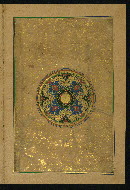Home > Digitized Walters Manuscripts
This document is a tranformation of a TEI P5 XML manuscript description incorporating images. If you have trouble reading special or non-Latin characters on this page, please make sure you have appropriate Unicode fonts installed and an up-to-date web browser.
Walters Ms. W.624, Five poems (quintet)
Browse images (Browse images in a new window) | TEI in XML format
W.624
Five poems (quintet)
Vernacular: خمسه دهلوى
Authority name: Amīr Khusraw Dihlavī, ca. 1253-1325
As-written name: Amīr Khusraw Dihlavī
Name, in vernacular: امير خسرو دهلوى
Note: Author dates preferred by cataloger: d. 725 AH / 1325 CE
This is a deluxe copy of the Khamsah (quintet) of Amīr Khusraw Dihlavī (d. 725 AH / 1325 CE). The manuscript was written in nastaʿlīq script by one of the greatest calligraphers of the Mughal atelier, Muḥammad Ḥusayn al-Kashmīrī, honored with the epithet Zarrīn Qalam (golden pen). This copy of Dihlavī's Khamsah, likely produced in Lahore (present-day Pakistan) in the late tenth century AH / sixteenth CE, is associated with the patronage of Akbar (r. 963-1014 AH / 1556-1605 CE). The manuscript bears the names of a number of painters and illuminators. The illustrations bear ascriptions to the following artists: Laʿl (Lāl), Manūhar, Sānwalah, Farrukh, Alīqulī, Dharamdās, Narsing, Jagannāth, Miskīnā, Mukund, and Sūrdās Gujarātī. The illuminators are Ḥusayn Naqqāsh, Manṣūr Naqqāsh, Khvājah Jān Shīrāzī, and Luṭf Allāh Muẕahhib. The borders are all elaborately illuminated with animal, bird, and geometric motifs, as well as human figures engaged in such activities as hunting, praying, and reading. The lacquer binding, decorated with pictorial scenes, is contemporary with the manuscript. Eight leaves from this copy of the Khamsah of Dihlavī are housed in the Metropolitan Museum of Art (13.228.26-33).
The date reads 142 (!). It has been interpreted as the 42nd year of Emperor Akbar's reign, i.e. March 1597 -- March 1598 CE.
Probably Lahore (present-day Pakistan)
As-written name: Manṣūr Naqqāsh
Name, in vernacular: منصور نقاش
Note: See bibliography: Verma, 261-271; Seyller, 119-123, 131-132
As-written name: Khvājah Jān Shīrāzī
Name, in vernacular: خواجه جان شيرازي
Note: See bibliography: Verma, 220; Seyller, 120, 123
As-written name: Luṭf Allāh muẕahhib
Name, in vernacular: لطف الله مذهب
Note: See bibliography: Verma, 233; Seyller, 120, 123
As-written name: Ḥusayn Naqqāsh
Name, in vernacular: حسين نقاش
Note: See bibliography: Verma, 179; Seyller, 120, 122-123
As-written name: Laʿl (Lāl)
Name, in vernacular: لعل
Note: See bibliography: Verma, 221-231; Seyller, 54 (reads name as Lāla)
As-written name: Manūhar
Name, in vernacular: منوهر
Note: See bibliography: Verma, 248-259; Seyller, 39-40, 58, 96, 98, 138
As-written name: Sānwalah
Name, in vernacular: سانوله
Note: See bibliography: Verma, 342-345; Seyller 31, 42, 60, 62, 80, 82, 112
As-written name: Farrukh
Name, in vernacular: فرخ
Note: See bibliography: Verma, 144-146; Seyller 31, 42, 66, 94
As-written name: ʿAlīqulī
Name, in vernacular: عليقلي
Note: See bibliography: Verma, 58; Seyller 42, 68
As-written name: Dharamdās
Name, in vernacular: دهرمداس
Note: See bibliography: Verma, 137-141; Seyller, 31, 42, 44, 64, 70, 74, 84, 110-111 (reads name as Dharmadāsa)
As-written name: Narsing
Name, in vernacular: نرسنگ
Note: See bibliography: Verma, 320-322; Seyller 31, 48, 76
As-written name: Jagannāth
Name, in vernacular: جگنات
Note: See bibliography: Verma, 192-193; Seyller 31, 44, 78
As-written name: Miskīnā
Name, in vernacular: مسكينا
Note: See bibliography: Verma, 287-291; Seyller, especially 94
As-written name: Mukund
Name, in vernacular: مكند
Note: See bibliography: Verma, 304-330; Seyller, especially 100
As-written name: Sūrdās Gujarātī
Name, in vernacular: سورداس كجراتي
Note: See bibliography: Verma, 360-361; Seyller, especially 102
As-written name: Muḥammad Ḥusayn Zarrīn Qalam
Name, in vernacular: محمد حسين زرين قلم
Known as: Muḥammad Ḥusayn al-Kashmīrī
Note: See bibliography: Seyller, 39-41
Book
Literary -- Poetry
The primary language in this manuscript is Persian.
- Transliteration: al-ʿabd al-faqīr al-ḥaqīr /1/ Muḥammad Ḥusayn Zarrīn Qalam fī tarīkh sanat 142 [sic] /2/ bi-itmām rasīd /3/
- Comment: The colophon gives the name of the calligrapher as Muḥammad Ḥusayn Zarrīn Qalam and the date 142, which is difficult to interpret. Seyller and Brend read it as dated 42 and thus interpret it as the 42nd year of Emperor Akbar’s reign, i.e. March 1597 -- March 1598 CE. According to Seyller, the vertical stroke that precedes the 42 should be regarded as an extended dot over the nūn in the word sana (year). According to Brend, the vertical stroke should be read as an alif for ilāhī.
Paper
Laid paper
Foliation: 211
Original folio numbers written in the lower left of most folios (on versos) amid the rocks and foliage of the borders
Catchwords: Written on versos
Comments:
19.0 cm wide by 28.5 cm high
10.0 cm wide by 17.0 cm high
- Columns: 4
- Ruled lines: 21
- Framing lines in gold, green, blue, and black
- Title: Khamsah-i Dihlavī
- Author: Amīr Khusraw Dihlavī, ca. 1253-1325
- Scribe: Muḥammad Ḥusayn Zarrīn Qalam
- Artists: Laʿl (Lāl); Manūhar; Sānwalah; Farrukh; ʿAlīqulī; Dharamdās; Narsing; Jagannāth; Miskīnā; Mukund; Sūrdās Gujarātī; Manṣūr Naqqāsh; Khvājah Jān Shīrāzī; Luṭf Allāh muẕahhib; Ḥusayn Naqqāsh
- Incipit: بسم الله الرحمن الرحيم خطبه قدست بملك قديم...
- Text note: Contains: Maṭlaʿ al-anvār (fols. 1a-41b), Shīrīn va Khusraw (fols. 42b-89b), Majnūn va Laylá (fols. 90b-119b, end missing), Āʾīnah-i Sikandarī (fols. 120a-173a, missing the first folio with the frontispiece and the incipit page), and Hasht bihisht (fols. 174b-211a); twenty-two folios missing from the original codex; lacunae at the following junctures: fols. 11/12, 15/16, 21/22, 28/29, 58/59 (four missing folios), 119/120 (six missing folios), 149/150, 157/158, 164/165, 181/182 (two missing folios), 184/185 (two missing folios), and 198/199
- Hand note: Written in nastaʿlīq script in black, red, and blue ink
- Decoration note: Twenty-one illustrations (some inscribed): fols. 24b, 35a (ʿamal-i Laʿl), 40a, 51a (ʿamal-i Manūhar), 58a (ʿamal-i Sānwalah), 59a (ʿamal-i Sānwalah), 66b, 80a (ʿamal-i Farrukh), 94b (ʿamal-i ʿAlīqulī), 98a (ʿamal-i Dharamdās), 100b (ʿamal-i Laʿl), 113a, 115a (ʿamal-i Narsing), 128a (Jagannāth), 135a, 139a, 153b, 182b (Miskīnā and Farrukh), 188a, 203b (ʿamal-i Mukund), and 208b (ʿamal-i Sūrdās Gujarātī); two frontispieces (fols. 1a and 42a); two finispieces (fols. 173b and 211b); fol. 42a signed: ʿamal-i Ḥusayn Naqqāsh; four signed headpieces introducing various poems: fols. 1b (dhahhabahu Manṣūr Naqqāsh), 42b (Khvājah Jān Shīrāzī), 90b (ʿamal-i Luṭf Allāh muẕahhib), and 174b (Ḥusayn); borders illuminated with a wide variety of motifs. “Ten of the original thirty-one illustrations have been separated from the Walters Khamsa. Eight of these paintings made their way to the Metropolitan Museum of Art in the early twentieth century…” (Seyller, 41).
fol. 1a:
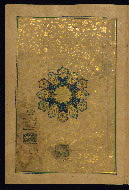
- Title: Illuminated frontispiece with shamsah
- Form: Frontispiece
- Label: This illuminated frontispiece has a central twelve-pointed star (shamsah). The page is further decorated with floral motifs executed in gold. There are five seals.
fol. 1b:
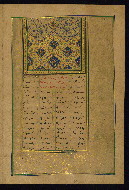
- Title: Incipit page with illuminated headpiece
- Form: Incipit; headpiece
- Text: Maṭlaʿ al-anvār
- Label: This incipit page with illuminated headpiece introduces the first poem of the Khamsah, Maṭlaʿ al-anvār. The illumination was done by Manṣūr Naqqāsh ('dhahhabahu Manṣūr). His name is inscribed in the two small illuminated rectangles flanking the rubric.
fol. 24b:
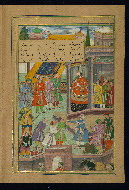
- Title: Fratricide witnesses the loyalty of two friends
- Form: Illustration
- Text: Maṭlaʿ al-anvār
- Label: This illustration depicts the tenth maqāla (discourse). Two men who are about to be executed are found in the lower foreground. Several men plea to the king for clemency.
fol. 35a:
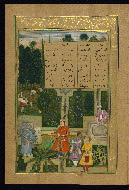
- Title: An old Sufi laments his lost youth
- Form: Illustration
- Text: Maṭlaʿ al-anvār
- Label: This garden scene relates the seventeenth maqāla (discourse). An elderly sufi makes a romantic gesture toward a young handsome man in an orange jama. This illustration is the work of ʿamal-i Laʿl (Lāl).
fol. 40a:
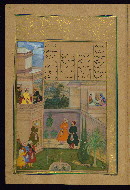
- Title: A virtuous woman placates the king by plucking out her eyes
- Form: Illustration
- Text: Maṭlaʿ al-anvār
- Label: This illustration depicts the twentieth maqāla (discourse), which emphasizes female virtue. The king relentlessly pursues the female protagonist, claiming that he cannot resist her beautiful eyes. To escape his amorous advances, the woman plucks out her eyes and sends them to him. She thus chooses virtue over all else, even her ability to see.
fol. 42a:
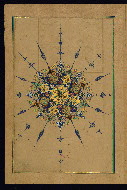
- Title: Illuminated frontispiece
- Form: Frontispiece
- Text: Shīrīn va Khusraw
- Label: This is the illuminated frontispiece to the second poem of the Khamsah, Shīrīn va Khusraw. It is signed ʿamal-i Ḥusayn Naqqāsh.
fol. 42b:
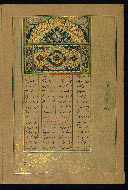
- Title: Incipit page with illuminated headpiece
- Form: Incipit; headpiece
- Text: Shīrīn va Khusraw
- Label: This incipit page with illuminated headpiece introduces the second poem of the Khamsah, Shīrīn va Khusraw. It is signed by Khvājah Jān Shīrāzī in the small cartouches flanking the white border that defines the large illuminated rectangle. The decorated border features a figure of a man in a posture of supplication.
fol. 51a:
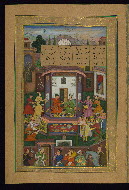
- Title: Shīrīn entertains Khusraw
- Form: Illustration
- Text: Shīrīn va Khusraw
- Label: This pavilion scene depicts the Armenian princess Shīrīn welcoming Khusraw in Armenia. The illustration is the work of (ʿamal-i) Manūhar.
fol. 58a:
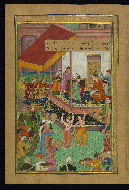
- Title: Khusraw and Shīrīn preside over the wedding of youths
- Form: Illustration
- Text: Shīrīn va Khusraw
- Label: The union of ten couples had been arranged by Khusraw, who sits with Shīrīn in celebration. In the spirit of the happy ceremony, Khusraw asks Shīrīn to marry him. Although in love with him, the Armenian princess declines. The inscription in red in the border reads ʿamal-i (the work of) Sānwalah.
fol. 59a:
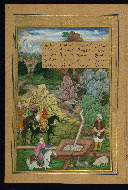
- Title: Shīrīn encounters the sculptor Farhād
- Form: Illustration
- Text: Shīrīn va Khusraw
- Label: On horseback, Shīrīn approaches the sculptor Farhād. The milk flowing through the channel recalls Shīrīn's request that Farhād cut a path through the mountain to bring milk from his flocks to her pavilion. Below the image, the border is inscribed ʿamal-i (work of) Sānwalah.
fol. 66b:
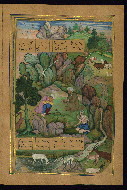
- Title: Farhād hears the false news of Shīrīn’s death
- Form: Illustration
- Text: Shīrīn va Khusraw
- Label: Farhād is shown in great sorrow as he is told that Shīrīn has died. It is Khusraw, in disguise, who relates this untruth.
fol. 80a:
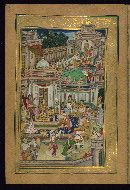
- Title: Shīrīn receives a ring from Khusraw
- Form: Illustration
- Text: Shīrīn va Khusraw
- Label: Both Shīrīn and Khusraw celebrate their upcoming nuptials in their respective pavilions. Below the image and written in red is ʿamal-i (the work of) Farrukh (Chela).
fol. 90b:
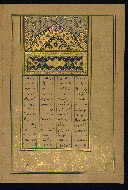
- Title: Incipit page with illuminated headpiece
- Form: Incipit; headpiece
- Text: Majnūn va Laylá
- Label: This incipit page with illuminated headpiece introduces the third poem of the Khamsah, Majnūn va Laylá. It is signed ʿamal-i Luṭf Allāh muẕahhib.
fol. 94b:
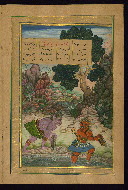
- Title: King Solomon and two demons
- Form: Illustration
- Text: Majnūn va Laylá
- Label: This illustration depicts the story of two divs (demons) who, out of boredom, wreak havoc on the world. Recognizing the dangers of idleness, the wise King Solomon consigns them to a life of futile activity: filling the sea with sand and the desert with water. The inscription naming the artist ‘Ali Quli is composed in red ink at the bottom of the page.
fol. 98a:
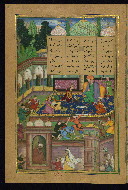
- Title: Laylá and Majnūn fall in love at school
- Form: Illustration
- Text: Majnūn va Laylá
- Label: Laylá and Majnūn, the ill-fated lovers, are depicted at school as youths. ʿAmal-i Dharamdās is inscribed in the border.
fol. 100b:
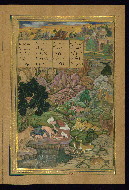
- Title: Majūn is visited in the wilderness by his father
- Form: Illustration
- Text: Majnūn va Laylá
- Label: Majūn, emaciated and living with the beasts of the wilderness, is visited by his father. Inscribed in red ink below the image is ʿamal-i (work of) Laʿl.
fol. 113a:
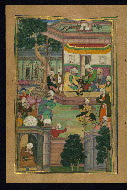
- Title: Majnūn befriends a dog
- Form: Illustration
- Text: Majnūn va Laylá
- Label: Majnun is shown holding a stray dog found near Laylá's home.
fol. 115a:
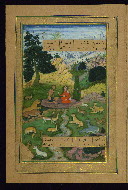
- Title: Laylá visits Majnūn in the wilderness
- Form: Illustration
- Text: Majnūn va Laylá
- Label: The ill-fated lovers Majnūn and Laylá meet in the wilderness surrounded by the beasts befriended by Majnun. ʿAmal-i (work of) Narsing is inscribed in red below the image.
fol. 128a:
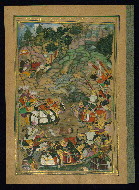
- Title: Alexander the Great lassos an opponent
- Form: Illustration
- Text: Āʾīnah-i Sikandarī
- Label: This illustration depicts one of the many battles fought by Alexander the Great, who is celebrated in the Islamic tradition as one of the great historic rulers. The painting is inscribed Jagannāth in red ink.
fol. 135a:
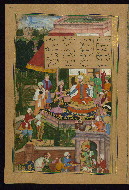
- Title: Alexander the Great discovers Kanīfū’s identity
- Form: Illustration
- Text: Āʾīnah-i Sikandarī
- Label: When the brave captive Chinese warrior Kanīfū is stripped of armor, Alexander the Great and his retinue are amazed to discover that the warrior is a woman.
fol. 139a:

- Title: The Khāqān of China pays homage to Alexander the Great
- Form: Illustration
- Text: Āʾīnah-i Sikandarī
- Label: The Khāqān of China prostrates himself before Alexander the Great. The gifts offered to the latter are seen in the foreground.
fol. 153b:
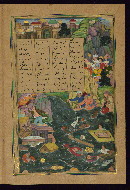
- Title: Alexander the Great drowns the Greeks
- Form: Illustration
- Text: Āʾīnah-i Sikandarī
- Label: The Greeks are punished for not accepting the faith and rule of Alexander the Great.
fol. 173b:
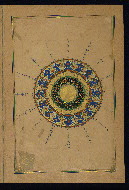
- Title: Illuminated finispiece
- Form: Finispiece
- Text: Āʾīnah-i Sikandarī
- Label: This illuminated finispiece in the form of a circular medallion marks the end of the fourth poem of the Khamsah, Āʾīnah-i Sikandarī.
fol. 174b:
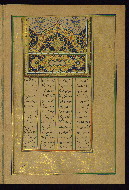
- Title: Incipit page with illuminated headpiece
- Form: Incipit; headpiece
- Text: Hasht bihisht
- Label: This incipit page with illuminated headpiece introduces the fifth poem of the Khamsah, Hasht bihisht. It is signed by Ḥusayn (Naqqāsh).
fol. 182b:
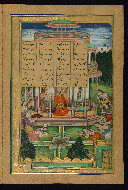
- Title: The princesses of the seven pavilions bow in homage to Bahrām Gūr
- Form: Illustration
- Text: Hasht bihisht
- Label: The princesses of the seven pavilions bow before Bahram Gur. Each of them will lead Bahram on a journey from a pleasure-seeking prince to a wise and just king. This illustration is the work of Miskīnā and Farrukh.
fol. 188a:
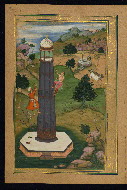
- Title: The story of the goldsmith's foolish wife as told by the princess of the yellow pavilion
- Form: Illustration
- Text: Hasht bihisht
- Label: This illustration depicts the story told to Bahram Gūr by the princess of the yellow pavilion. It is a tale of a woman who foolishly implicates her husband, a goldsmith, in a crime against the king. He is thus imprisoned in a high tower. He decides to trick his dim-witted wife so that she will exchange places with him. The image shows how the goldsmith lowers himself down and his wife up to the tower.
fol. 203b:
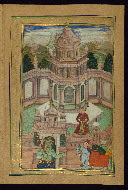
- Title: The story of the man falsely accused of incest as told by the princess of the sandalwood pavilion
- Form: Illustration
- Text: Hasht bihisht
- Label: This illustration depicts the story told to Bahram Gūr by the princess of the sandalwood pavilion. The young prince who was wrongfully accused of incest follows the advice of three friends to exonerate himself. He is shown meditating upon a statue, as instructed. At the bottom of the page is inscribed ʿamal-i (the work of) Mukund.
fol. 208b:
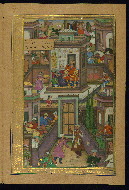
- Title: The story of the talisman that detects insincerity as told by the princess of the white pavilion
- Form: Illustration
- Text: Hasht bihisht
- Label: This illustration depicts the story told to Bahram Gūr by the princess of the white pavilion. It is a tale of a king on a quest for a sincere woman to marry. He is given a talisman to help him in his search. The talisman laughs whenever a woman is insincere. In this image, the gold statue laughs as a woman pretends to faint. Below the image is inscribed ʿamal-i (work of) Sūrdās Gujarātī.
fol. 211b:
The binding is original.
Lacquer with pictorial scenes (no flap): upper board depicts an encounter between a prince and a reclusive sage; lower board depicts a host of fairies pummeling some outnumbered dīvs; doublures decorated with a field of small floral patterns; restored probably in Europe in the thirteenth century AH / nineteenth CE
Oval seal: Muḥammad Zakī, 1241 AH / 1825-6 CE (fols. 1a, 211a)
Oval seal: Muḥammad Zakī, 1241 AH / 1825-6 CE (fols. 1a, 211a)
Rectangular seal: ʿabd al-rājī Muḥammad Shafīʿ, 1247 AH / 1831-2 CE (fols. 1a, 211a)
Large oval seal: Muhammad ʿAlī, no date (fol. 211a)
Walters Art Museum, 1931, by Henry Walters bequest
Brend, Barbara. "Akbar's Khamsah of Amir Khusraw Dihlavi: A Reconstruction of the Cycle of Illustrations." Artibus Asiae 49 (1988/89): 281-315.
Verma, Som Prakash. Mughal Painters and their Work: A Biographical Survey and Comprehensive Catalogue. Aligarh: Centre of Advanced Study in History, Aligarh Muslim University; Delhi: Oxford University Press, 1994.
Seyller, John. Pearls of the Parrot of India: The Walters Art Museum Khamsa of Amīr Khusraw of Delhi. Baltimore: Walters Art Museum, 2001.
Brend, Barbara. Perspectives on Persian Painting: Illustrations to Amīr Khusrau's Khamsah. London; New York: Routledge/Curzon, 2003.
Blair, Sheila. Islamic Calligraphy. Edinburgh: Edinburgh University Press, 2007.
Principal cataloger: Gacek, Adam
Catalogers: Landau, Amy; Smith, Sita
Copy editor: Bockrath, Diane
Conservators: Jewell, Stephanie; Quandt, Abigail
Contributors: Barrera, Christina; Emery, Doug; Herbert, Lynley; Noel, William; Simpson, Shreve; Tabritha, Ariel; Toth, Michael B.; Valle, Chiara
The Walters Art Museum
Licensed for use under Creative Commons Attribution-NonCommercial-ShareAlike 3.0 Unported Access Rights, http://creativecommons.org/licenses/by-nc-sa/3.0/legalcode. It is requested that copies of any published articles based on the information in this data set be sent to the curator of manuscripts, The Walters Art Museum, 600 North Charles Street, Baltimore MD 21201.
